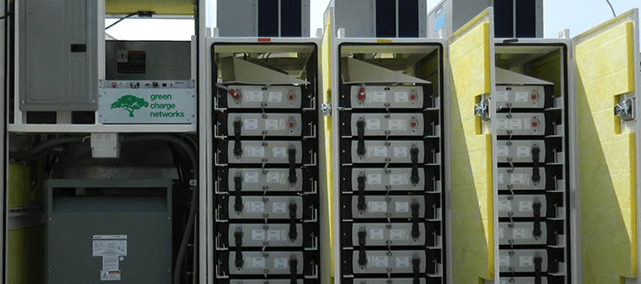The energy service company model has proved crucial to making energy-efficiency retrofits, solar energy installations and even LED lighting conversions doable for organizations not willing or able to pay the upfront capital costs.
Now, we’re seeing this model take root in the area of energy storage.
Santa Clara, Calif.-based Green Charge Networks (GCN) has raised $56 million in equity financing to grow its storage-as-a-service offering, which gives customers a way to avoid power demand charges that in some jurisdictions can represent up to half an electricity bill.
The concept is dead simple: GCN agrees, at its own expense, to install and manage energy storage – in this case, a whack of Samsung lithium-ion batteries — at a customer’s site. The storage equipment, called a GreenStation, charges when the customer’s power demand is typically low and discharges when it is high. Ideally, the peaks and valleys offset each other, and sophisticated predictive software helps to make sure that happens.
Why is this important? Because many jurisdictions, such as New York, California and Ontario, charge companies a hefty premium when they exceed a specific power demand threshold during certain times of the day. Billions of dollars a year are paid out annually by those required to pay demand charges. Smooth out the power use to avoid those peak charges and the result can be big savings.
Under a Power Efficiency Agreement, GCN “installs, owns, operates and maintains the GreenStation equipment at the host location, in return receiving a share of the energy bill savings at the customer site,” according to the company, calling it a “zero-down solution that presents no risk to the host customers.”
GCN, which has focused most of its marketing on New York and California, has installed its systems at Walgreens, 7-Eleven and UPS locations and in many municipal buildings, such as schools.
“This type of financing model was key to spreading distributed solar around the globe, but has not been available in the energy storage market until now,” the five-year-old company said in a statement. “This financing allows Green Charge to serve the broadest cross-section of the market.”
Vic Shao, chief executive of GCN, called power efficiency “the next frontier in energy savings.”
GNC isn’t the only company exploring this market, nor is energy storage the only solution for reducing peak charges. Enbala Networks, for example, can control a facility’s large loads – such as pumps and fans – to reduce their operation when peak charges are highest, while Regen Energy can manage loads within a facility using “swarm logic” to make sure equipment isn’t operating unnecessarily at the same time.
Outside of energy storage as a way to help customers manage their power consumption, the technology is increasingly being used on a larger scale to help keep the electrical grid in balance.
This week, Ontario’s Independent Electricity System Operator announced that five companies had been awarded contracts to deliver up to 34 megawatts of storage, through a mix of battery, thermal, flywheel and hydrogen technologies.
The Ontario Power Authority, the province’s long-term energy planner, is expected to award another 15 megawatts worth of contracts later this year.
“We’re building a smarter, more advanced grid that will ensure our entire system uses energy as efficiently as possible,” Ontario Energy Minister Bob Chiarelli said in a statement.
Last week, Toronto-based flywheel company Temporal Power flicked the switch on a new flywheel installation in Ontario that will supply 2 megawatts of energy storage capacity. It will be used to dynamically balance supply and demand on the grid, also known as a regulation service (part of what’s called “ancillary” services).
It is the first grid-connected commercial flywheel system operating in Canada.
The global market for ancillary services is expected to grow significantly, reaching 3,500 megawatts installed by 2023, according to Navigant Research.







